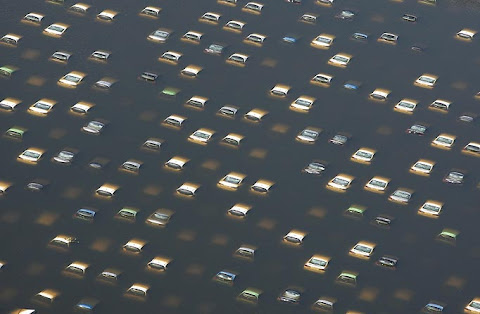Japanese automaker Honda began destroying more than 1,000 cars in Thailand to reassure customers that no vehicles damaged in the country's recent flood crisis will ever be sold.
The scrapping process at Honda's plant in the central province of Ayutthaya is expected to take one month, the company said in a statement.
The plant is located in the Rojana Industrial Park, where heavy flooding in early October brought production to a halt and aerial pictures showed hundreds of new cars submerged in muddy water.
"While we were able to relocate many new cars that were awaiting shipment to a safe area, 1,055 vehicles that remained in the plant were finally damaged by the flood," said Pitak Pruittisarikorn, executive vice president of Honda Automobile Thailand.
"We will not sell any of the damaged cars to customers, or sell or reuse any of the parts," he added.
Most of the cars to be scrapped are mid-sized City sedans and Brio and Jazz hatchbacks. Production has yet to resume at the factory.
This aerial picture shows cars submerged in floodwaters at a Honda car factory outside the ancient Thai capital of Ayutthaya, north of Bangkok.
This aerial picture shows damaged dried up cars after floodwaters receded at a Honda car factory outside the ancient Thai capital of Ayutthaya, north of Bangkok.
Honda Automobile (Thailand) has kicked off a major program to scrap a total of 1055 cars that were affected by the flood in its plant in central Thailand, the company announced on Tuesday(27th December 2011).
The cars included 217 units of Brio, 213 units of Jazz, 353 units of City, 150 units of Civic, 91 units of Accord, 30 units of CR-V and 1 unit of Freed.
"We made every effort to protect our plant, but with the massive amount of flood water.. 1055 vehicles that remained in the plant were finally damaged by the flood," Pitak Pruittisarikorn, executive vice president of Honda Thailand, told a press conference.
On-site demonstrations showed that the specialist workers hired by Honda to dismantle the cars first, drain the remaining liquids from the engine and then dissemble the car by delicate steps. Finally, the skeleton of the car was lifted by a crane into a gigantic mobile pressing machine which turned it into a compressed cube for recycling purposes.
According to Pitak, the process of scrapping the cars, which is expected to be finished within one month, had stringent controls to ensure that it was done in an environmentally- responsible way.
The program was a reflection of Honda's commitment to delivering the "highest quality" to its customers, Pitak added, " We will not sell any of the damaged cars to customers, or reuse any of the parts".
To ensure transparency, the vehicle identification numbers of all the cars will be made public on the website of Honda (Thailand) .
Close up picture of Honda car factory outside the ancient Thai capital of Ayutthaya, north of Bangkok after floods subsided.
Workers at Honda car factory outside the ancient Thai capital of Ayutthaya, north of Bangkok inspecting flood damaged cars.
Video below shows how Honda Thailand factory cleans up and scrapped all irreparable damaged cars to restore customer confidence.




